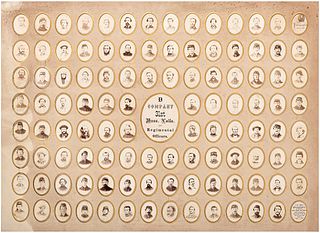The Battle of Fort Bisland was fought in the American Civil War between Union Major General Nathaniel P. Banks against Confederate Major General Richard Taylor during Banks' operations against the Bayou Teche region in southern Louisiana.
The 53rd Massachusetts Volunteer Infantry was an infantry regiment recruited in Massachusetts for service in the American Civil War. The volunteers, mostly farmers, predominantly hailed from north-central Massachusetts.
The 26th Maine Infantry Regiment was an infantry regiment that served in the Union Army during the American Civil War.

1st Regiment Indiana Heavy Artillery was a heavy artillery regiment that served in the Union Army during the American Civil War. It was nicknamed the "Jackass Regiment". Before being converted into an artillery unit in 1863, it served as the 21st Regiment, Indiana Volunteer Infantry.
The 12th Connecticut Infantry Regiment was an infantry regiment that served in the Union Army during the American Civil War.

The 75th New York Infantry Regiment was an infantry and mounted infantry regiment in the Union Army during the American Civil War.
The 30th Massachusetts was an infantry regiment that served in the Union Army during the American Civil War.

The 31st Massachusetts was an infantry regiment that served in the Union Army during the American Civil War. It was converted into a mounted infantry regiment in December 1863.

The 156th New York Infantry Regiment was an infantry regiment in the Union Army during the American Civil War.

The 133rd New York Volunteer Infantry was an infantry regiment in the Union Army during the American Civil War.
The 173rd New York Infantry Regiment was an infantry regiment in the Union Army during the American Civil War.

The 110th New York Infantry Regiment was an infantry regiment in the Union Army during the American Civil War.

The 131st New York Infantry Regiment was an infantry regiment in the Union Army during the American Civil War.

The 163rd New York Infantry Regiment was an infantry regiment in the Union Army during the American Civil War.
The 3rd Massachusetts Volunteer Cavalry Regiment was a cavalry regiment that served in the Union Army during the American Civil War. It was organized by consolidating the 41st Massachusetts Mounted Infantry and the 2nd Battalion Massachusetts Cavalry on June 17, 1863. The regiment served with the XIX Corps, Army of the Gulf during the Red River Campaign in 1864. Its heaviest combat during this campaign took place during the Battle of Sabine Crossroads.

The 50th Regiment Massachusetts Volunteer Infantry was a regiment of infantry that served in the Union Army during the American Civil War. It was one of the 18 Massachusetts regiments formed in response to President Abraham Lincoln's August 1862 call for 300,000 men to serve for nine months. The regiment was recruited in Essex County and rendezvoused for mustering in at Camp Edwin M. Stanton in Boxford, Massachusetts. The 50th Massachusetts was assigned to the Department of the Gulf under Major General Nathaniel P. Banks and shipped for Louisiana. The regiment saw combat during the Siege of Port Hudson.

The 6th Massachusetts Battery was an artillery battery that served in the Union Army during the American Civil War. The unit was one of the Massachusetts regiments organized in response to President Abraham Lincoln's call on May 2, 1861 for volunteer troops to serve a term of three-years. The battery trained at Camp Chase in Lowell, Massachusetts. It was assigned to the Department of the Gulf under Major General Benjamin F. Butler and departed Boston by steamship on February 8, 1862. At that time, the unit comprised 145 men armed with two rifled and four smoothbore six-pounder field guns.

The 2nd Louisiana Cavalry Regiment was a unit of mounted volunteers recruited in Louisiana that fought in the Confederate States Army during the American Civil War. Breazeale's Cavalry Battalion was formed in July 1862 and was augmented by five additional companies in September 1862 to form a regiment. It served for the entire war west of the Mississippi River in the Trans-Mississippi Department. The regiment fought at Georgia Landing, Fort Bisland, Irish Bend, and Brashear City in 1863 and Henderson's Hill and Mansfield in 1864. Afterward, the regiment fought in minor skirmishes before the Trans-Mississippi's final surrender on 26 May 1865.
1st U.S. Artillery, Battery F was a United States Army field artillery battery that was in service between 1821 and 1901, most notably in extensive service with the Union Army during the American Civil War. In that conflict, the battery was engaged at the battles of Pensacola, Fort Bisland, Vermilion Bayou, Port Hudson, and Mansura.

Oliver Paul Gooding was an officer in the Union Army during the American Civil War and was brevetted Major General for his war service. He graduated from the United States Military Academy in 1858 and served in the Utah expedition. After the Civil War broke out he was named colonel of an infantry regiment and accompanied the New Orleans expedition in 1862. He led an infantry brigade at Fort Bisland and Port Hudson in 1863. He led a cavalry brigade in the Red River campaign in 1864. After the war he practiced law and wrote two religious books.







